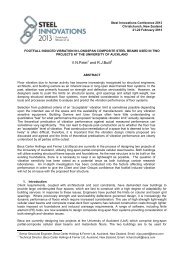Environmental Impacts of Multi-Storey Buildings Using Different ...
Environmental Impacts of Multi-Storey Buildings Using Different ...
Environmental Impacts of Multi-Storey Buildings Using Different ...
Create successful ePaper yourself
Turn your PDF publications into a flip-book with our unique Google optimized e-Paper software.
- 15 -designers and a shortage <strong>of</strong> building design practitioners who are trained and experienced inthe use <strong>of</strong> wood as a construction material for large buildings.The information gap noted above is there because few have seen the need for this informationuntil now, there are few examples and very few advocates.Further impetus for this research was provided by the introduction <strong>of</strong> the New Zealand GreenBuilding Council (NZGBC) Green Star Office rating tool (v1.0) which does not consider thefull LCA <strong>of</strong> building materials; it does not consider embodied energy, nor give fairconsideration to the displacement <strong>of</strong> more energy intensive building materials by wood, norprovide recognition <strong>of</strong> the ability to use wood waste to generate energy. Current research wasneeded to demonstrate the perceived shortcomings <strong>of</strong> the NZGBC rating tool and <strong>of</strong>feralternatives.The initial research contract had three programme objectives:Objective 1 To design three comparable buildings with the following structuralmaterials; conventional reinforced concrete, conventional steel andinnovative pre-stressed timber. MAF RFP POR/7811 providedmethodology and design guides for the building.Objective 2 To investigate both the embodied energy in the structural and nonstructuralmaterials and the whole-<strong>of</strong>-life operational energy <strong>of</strong> eachbuilding design, together with lifetime GWP emissions.Objective 3 To demonstrate and highlight any differences between the total whole-<strong>of</strong>lifeenergy <strong>of</strong> each building, together with lifetime GWP emissions.The research was extended in December 2007 to;• Design a fourth structure, the TimberPlus building. This design was to go well beyondsubstituting the mainly structural components <strong>of</strong> the building to redesign the wholearchitecture, both internal and external. (For instance, the TimberPlus buildingmaximises the use <strong>of</strong> wood through timber external cladding and internal partitions, andincorporates timber framed windows, doors and stairs). The TimberPlus option needed tomaximise the use <strong>of</strong> wood but not beyond what would be a reasonable expectation botharchitecturally and aesthetically, whilst still <strong>of</strong>fering a realistic maintenance schedule andwithin a similar budget to the Concrete and Steel options.• Undertake additional work on the Steel building to allow the Steel building to be broughtup to a more comparable level <strong>of</strong> design and research, similar to that for the Concrete andTimber options, and thus allow a more rigorous comparison <strong>of</strong> the four alternativedesigns.• Extend the work on the schedule <strong>of</strong> materials for each building undertaken by theQuantity Surveyor to include the following categories; glass, aluminium, paint andfinishes, particleboard/fibreboard and insulation.• Undertake additional investigation by the Quantity Surveyor to provide a betterunderstanding <strong>of</strong> where environmental impacts are greatest.• Include the effects <strong>of</strong> building maintenance and refurbishment in the life cycleassessment.• Expand the LCA work to include a sensitivity analysis on the environmental impacts <strong>of</strong>the transport distances <strong>of</strong> wood and other materials used in the buildings• Expand the end-<strong>of</strong>-life aspect <strong>of</strong> the original LCA modelling work to investigate andreport on the effects <strong>of</strong> landfilling <strong>of</strong> demolition waste and the possibilities for both the
















